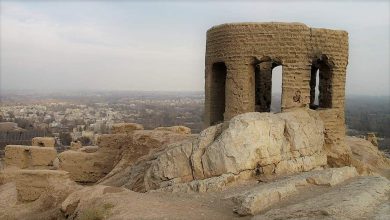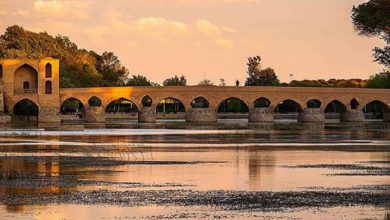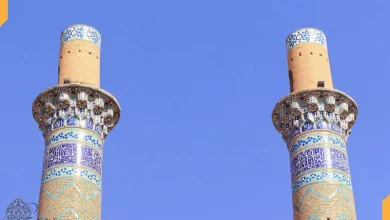Ghalamkari
Ghalamkari is the art of printing or delineating the fabric. When you walk in Isfahan bazaar, patterned fabrics attract your attention and with a little query, you’ll know that these patterns are the result of Ghalamkari art. Here is more information about the short history, usages and all the things that relate to this ancient art.
What is Ghalamkari art?
Ghalamkari also called “Chit Sazi”, consisted of two words “Ghalam” and “Kari” it can mean the artwork that is done with a stylus.
Short History of Ghalamkari
Ghalamkari doesn’t have any obvious history, but the most complete explanation about this art relates to writing that exists in the third volume of Pope’s book that Philips Ackerman said on behalf of a writer that Ghalamkari art has emerged from the Ghaznavid period or 4th and 5th century.
This art developed in the 11th century during the king Abbas period due to the interest of courts in this industry and it reached perfection.
In this period, different Ghalamkari products were produced the most usable was “Zar or Aklil Ghalamkari” and most men’s and women’s clothes were produced with these fabrics.
A kind of Ghalamkari that was used for clothes, was called “Delge” that had special pattern.
After that, the nature and construction method of this art changed and it expanded significantly and also flourished in the Safavid period finally, it ended in the middle of the Qajar period.
In 10th century A.H, Gheisariye Bazaar that was located in Isfahan, was one of the centers of Ghalamkari production and its workshops were continued from Gheisariye portal to the end of bazaar.
There are other pieces of evidence that show this art was common in Timurid period and in cities like Borujerd
- Shiraz
- Rasht
- Nakhjavan
- Semnan
- Gonabad
- Mashhad
- Damghan
- Najaf Abad
- Isfahan
- and Hamedan.
At that time, the high-grade fabrics were from Borujerd and Isfahan city was one of the production centres of Ghalam Kari.
Today, most of the workshops are located in Khorzough city of Isfahan; so that we dare say that more than 70 % of Ghalamkar tablecloth of country is being produced in this region with traditional style and with pure linen fabrics and natural colors and being exported to all over Iran and world.
Ghalamkari and other arts
There are many similarities between patterns related to Ghalamkari and other arts like carpet- weaving, plastering, carving and etc.
this issue shows that artists combined the patterns of these arts together and they were providing a new pattern.
Also, the patterns of Iranian tiles from Safavid period have been taken from Iranian Ghalamkari and carpet-weaving patterns.
Ghalamkari Fabrics, Patterns, Colors, Printing Mold and Applications
Fabrics used in Ghalamkari are usually wool, cotton, Carbas and silk.
The best fabric for this art is cotton fabric because cotton fibres paint more easily than wool.
Different patterns are being used for this art that some of them includes:
- Historical landscapes
- wild and domestic animals
- miniature
- industrial hunting grounds,
- musicians
- rosette and arabesque traceries
- poet’s pictures
- the inscription
- gymnasium
- old stories of Persian literature
- Iranian lovers
- inscriptions adorned with poems (specially Mohtasham Kashani’s poems)
- historical events and subjects,
- epic stories of Ashura.
In the past, natural colours like herbal, animal and mineral colours were used in this art;
but today, because natural colours are difficult to prepare and get stable, chemical colours are being used.
It’s interesting to know that one of the sensitive steps of this profession is colouring that professors provide their intended colour according to their experience with simple and inexpensive ingredients like
- pomegranate skin
- sesame oil
- gum tragacanth
- rose
- grape syrup
- turmeric
- castor oil,
- black and white lye
- rust etc.
and after that, they prepare the preparations of fabric printing.
The main colours that are being used in this art include:
- black
- red
- blue
- green,
- and yellow
By blending the colours, we can make other shades of colours.
The printing mould is being built with pear and hawthorn tree wood because these woods are more resilient and stronger than other woods.
“Sketching” is the name of an operation in that wood is being transformed into a usable mould that all of these are done with the hand of artists.
After the mould gets ready, it became greased with tallow so that the wood doesn’t dry out and it doesn’t crack. It’s interesting to know that for printing one four-coloured design, four moulds are being produced and used separately.
Applications of Ghalamkari fabrics include:
- Tablecloth
- Counterpane
- Table linen
- Prayer rug
- Bundle
- Bag
- Scarf
- Napkin
- Ascot, etc.
Steps of Ghalamkari:
At first, requisite colours should be produced and also combined.
The fabrics that should be designed, have been put in the river for 5 days to remove waste materials.
Before printing the pattern, the pea field dyeing of fabric is done with pomegranate skin.
It’s the turn of imprinting the fabric and different patterns are being printed on fabric with wooden moulds.
After imprinting with black and red colours, the fabric is washed in running water for 2 or 3 hours until its extra colours are removed.
The fabric is being dried and getting ready for colour stabilization.
After the fabric is dried in the fresh air, the phases of tasseling are applied and get ready for the time to market.
FAQ
Which city has the most workshops?
Khorzough city
Can you name some of the applications of Ghalamkari fabrics?
Tablecloth, bag, etc.
Which kind of patterns are being used in this art?
Historical landscapes, wild and domestic animals, etc.
Conclusion
Everywhere that we want to talk about art and handicraft, we remember Isfahan; the city of culture and art. One of Isfahan’s arts and handicrafts is Ghalamkari art.
Isfahan city is being introduced as the candidate of Ghalamkari global city on behalf of cultural heritage organization, handicrafts and tourism to the World Crafts Council and now, it is considered the only producer of Ghalamkari fabrics that are being produced in the traditional way
Have you ever bought any Ghalamkari products?
Do you like its patterns? Have you ever tried to do the phases of this art yourself?
Share your experiences with us…





